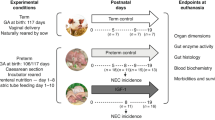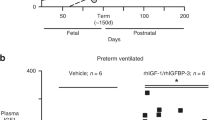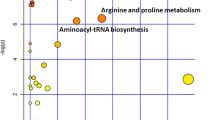Abstract
We have recently shown that the requirements of several amino acids differ substantially when neonates are fed parenterally as opposed to enterally. Our first objective was to determine whether the tryptophan requirement was different in parenterally fed (IVfed/IVdose) versus enterally fed (IGfed/IVdose) piglets. Because of the extensive extraction of amino acids by the gut, our other objective was to determine whether the route of isotope administration [i.e. intragastric (IGfed/IGdose) versus i.v. (IGfed/IVdose) dose] affects the estimate of tryptophan requirement in enterally fed piglets. We used the indicator amino acid oxidation technique in piglets (10 ± 0.5 d old, 2.79 ± 0.28 kg) receiving a complete elemental diet for 6 d either intragastrically or intravenously. Piglets were randomly assigned to receive test diets containing one of seven levels of tryptophan. All animals received a primed, constant infusion of l-[1-14C]phenylalanine either parenterally (IVfed/IVdose and IGfed/IVdose) or enterally (IGfed/IGdose). The mean tryptophan requirements for IVfed/IVdose (0.145 ± 0.023 g/kg/d), IGfed/IVdose (0.127 ± 0.022 g/kg/d), and IGfed/IGdose (0.113 ± 0.024 g/kg/d) were similar as were the safe intakes (upper 95% confidence interval) (0.185, 0.164, 0.154 g/kg/d, respectively). These data indicate that tryptophan is not extensively used by the gut, in contrast to all the other amino acids we have studied. Furthermore, in spite of a splanchnic extraction of 27% of the phenylalanine dose, the route of isotope infusion does not affect the tryptophan requirement as determined by indicator amino acid oxidation.
Similar content being viewed by others
Log in or create a free account to read this content
Gain free access to this article, as well as selected content from this journal and more on nature.com
or
Abbreviations
- CI:
-
confidence interval
- IAAO:
-
indicator amino acid oxidation
- IG:
-
intragastric
- IV:
-
intravenous
- SEE:
-
SE of the estimate
- SRA:
-
specific radioactivity
- TPN:
-
total parenteral nutrition
References
Pencharz PB 1986 Nutrition of the low birth weight infant. In: Grand RJ, Sutphen JL, Dietz WH (eds) Pediatric Nutrition: Theory and Practice. Butterworths, Boston, 313–326.
Brunton JA, Ball RO, Pencharz PB 2000 Current total parenteral nutrition solutions for the neonate are inadequate. Curr Opin Clin Nutr Metab Care 3: 299–304
Bertolo RFP, Chen CZL, Law G, Pencharz PB, Ball RO 1998 Threonine requirement of neonatal piglets receiving total parenteral nutrition is considerably lower than that of piglets receiving an identical diet intragastrically. J Nutr 128: 1752–1759
Bertolo RFP, Chen CZL, Pencharz PB, Ball RO 1999 Intestinal atrophy has a greater impact on nitrogen metabolism than liver by-pass in piglets fed identical diets via gastric, central venous or portal venous routes. J Nutr 129: 1045–1052
Bertolo RFP, Pencharz PB, Ball RO 2000 Organ and plasma amino acid concentrations are profoundly different in piglets fed identical diets via gastric, central venous or portal venous routes. J Nutr 130: 1261–1266
Stoll B, Henry J, Reeds PJ, Yu H, Jahoor F, Burrin DG 1998 Catabolism dominates the first-pass intestinal metabolism of dietary essential amino acids in milk-replacer-fed piglets. J Nutr 128: 606–614
House JD, Pencharz PB, Ball RO 1998 The lysine requirement of neonatal piglets receiving total parenteral nutrition determined by the oxidation of the indicator amino acidl -114C-phenylalanine. Am J Clin Nutr 67: 67–73
Wykes LJ, Ball RO, Pencharz PB 1993 The development and validation of a total parenteral nutrition model in the neonatal piglet. J Nutr 123: 1248–1259
Bross R, Ball RO, Pencharz PB 1998 Development of a minimally invasive protocol for the determination of phenylalanine and lysine kinetics in humans during the fed state. J Nutr 128: 1913–1919
Kriengsinyos W, Wykes LJ, Ball RO, Pencharz PB 2002 Effect of oral and intravenous tracer on the estimate of lysine requirement in healthy adult males usingl -[1-13C]phenylalanine as an indicator amino acid. J Nutr 132: 2251–2257
Matthews DE, Marano MA, Campbell RG 1993 Splanchnic bed utilization of leucine and phenylalanine in humans. Am J Physiol 264: E109–E118
Biolo G, Tessari P, Inchiostro S, Bruttomesso D, Fongher C, Sabadin L, Fratton MG, Valerio A, Tiengo A 1992 Leucine and phenylalanine kinetics during mixed meal ingestion: a multiple tracer approach. Am J Physiol 262: E455–E463
Hoerr RA, Matthews DE, Bier DM, Young VR 1993 Effects of protein restriction and acute refeeding on leucine and lysine kinetics in young men. Am J Physiol 264: E567–E575
Yu YM, Burke JF, Vogt JA, Chambers L, Young VR 1992 Splanchnic and whole bodyl -[1-13C,15N]leucine kinetics in relation to enteral and parenteral amino acid supply. Am J Physiol 262:E687–E694
Yu YM, Wagner DA, Tredget EE, Walaszewski JA, Burke JF, Young VR 1990 Quantitative role of splanchnic region in leucine metabolism: l -[1-13C,15N]leucine and substrate balance studies. Am J Physiol 259:E36–E51
el-Khoury AE, Basile A, Beaumier L, Wang SY, Al-Amiri HA, Selvaraj A, Wong S, Atkinson A, Ajami AM, Young VR 1998 Twenty-four-hour intravenous and oral tracer studies withl -[1-13C]-2-aminoadipic acid andl-[1-13C]lysine as tracers at generous nitrogen and lysine intakes in healthy adults. Am J Clin Nutr 68: 827–839
Hoerr RA, Matthews DE, Bier DM, Young VR 1991 Leucine kinetics from[2H]- and [13C]-leucine infused simultaneously by gut and vein. Am J Physiol 260:E111–E117
House JD, Pencharz PB, Ball RO 1997 Phenylalanine requirements determined by usingl -[1-14C]phenylalanine in neonatal piglets receiving total parenteral nutrition supplemented with tyrosine. Am J Clin Nutr 65: 984–993
Bidlingmeyer BA, Cohen SA, Tarvin TL 1984 Rapid analysis of amino acids using pre-column derivatization. J Chromatogr 336: 93–104
Kim KI, McMillan I, Bayley HS 1983 Determination of amino acid requirements of young pigs using an indicator amino acid. Br J Nutr 50: 369–382
Zello GA, Wykes LJ, Ball RO, Pencharz PB 1995 Recent advances in methods of assessing amino acid requirements for adult humans. J Nutr 125: 2907–2915
Lazaris-Brunner G, Rafii M, Ball RO, Pencharz PB 1998 Tryptophan requirement in young adult women determined by indicator amino acid oxidation withl -[13C]-phenylalanine. Am J Clin Nutr 68: 303–310
Elango R, Pencharz PB, Ball RO 2002 The branched-chain amino acid requirement of parenterally fed neonatal piglets is less than the enteral requirement. J Nutr 132: 3123–3129
Shoveller AK, Brunton JA, Pencharz PB, Ball RO 2003 The methionine requirement is lower in the parenterally fed neonatal piglet than in the enterally fed. J Nutr 133: 1390–1397
House JD, Pencharz PB, Ball RO 1997 Tyrosine kinetics and requirements during total parenteral nutrition in the neonatal piglet: the effect of glycyl-ltyrosine supplementation. Pediatr Res 41: 575–583
Roberts SA, Ball RO, Filler R, Moore A, Pencharz PB 1998 Phenylalanine and tyrosine metabolism in neonates receiving parenteral nutrition differing in pattern of amino acids. Pediatr Res 44: 907–914
Roberts SA, Ball RO, Moore AM, Filler RM, Pencharz PB 2001 The effect of graded intake of glycyl-l-tyrosine on phenylalanine and tyrosine metabolism in parenterally-fed neonates with an estimation of tyrosine requirement. Pediatr Res 49: 111–119
Ball RO, House JD, Wykes LJ, Pencharz PB 1996 A piglet model for neonatal amino acid metabolism during total parenteral nutrition. In: Tumbleson ME, Schook, LB (eds) Advances in Swine in Biomedical Research. Plenum Press, New York, 713–731.
Bross R, Ball RO, Clarke JT, Pencharz PB 2000 Tyrosine requirements in children with classical PKU determined by indicator amino acid oxidation. Am J Physiol 278: E195–E201
National Research Council 1998 Nutrient Requirements of Swine, 10th Ed. National Academy Press, Washington, DC, 159–162.
Ball RO, Bayley HS 1984 Tryptophan requirement of the 2.5-kg piglet determined by the oxidation of an indicator amino acid. J Nutr 114: 1741–1746
Sanchez M, el-Khoury AE, Castillo L, Chapman TE, Young VR 1995 Phenylalanine and tyrosine kinetics in young men throughout a continuous 24-h period, at a low phenylalanine intake. Am J Clin Nutr 61: 555–570
Author information
Authors and Affiliations
Corresponding author
Additional information
Supported by the Natural Sciences and Engineering Research Council of Canada, the Alberta Agricultural Research Institute, and Canadian Institutes of Health Research Fund Grant #MOP-12928.
Rights and permissions
About this article
Cite this article
Cvitkovic, S., Bertolo, R., Brunton, J. et al. Enteral Tryptophan Requirement Determined by Oxidation of Gastrically or Intravenously Infused Phenylalanine Is Not Different from the Parenteral Requirement in Neonatal Piglets. Pediatr Res 55, 630–636 (2004). https://doi.org/10.1203/01.PDR.0000113788.85515.7E
Received:
Accepted:
Issue date:
DOI: https://doi.org/10.1203/01.PDR.0000113788.85515.7E
This article is cited by
-
Tryptophan metabolism, from nutrition to potential therapeutic applications
Amino Acids (2011)



